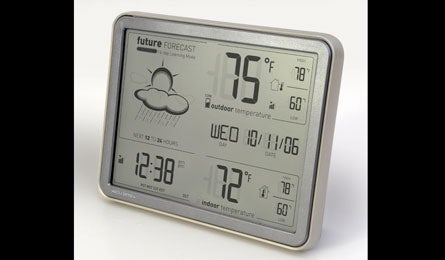Gear Review: Acu-Rite Wireless Weather Station and Weather Station Forecaster

'Wireless Weather Station Forecaster (Courtesy Photo)'
Weather. It can turn a short dayhike into a rainy, soggy mess, and many backcountry tragedies can be blamed on it. I’ve always been interested in weather, and while satellite forecasting and weather-at-your fingertips mobile apps are available when you’re online, I love being able to feel like a weatherman anytime I want without turning on my computer or scrolling through menus.
I tried out two indoor/outdoor weather stations from Acu-Rite, the basic Weather Station Forecaster, and the more advanced Wireless Weather Station, and found myself constantly checking the temperature, how the barometer was faring, and what my immediate local forecast was. Both models are entirely wireless, and include an outdoor sensor which reports temperature, humidity, barometric pressure, and a forecasting function which was surprisingly accurate. The more sophisticated Wireless Weather Station comes equipped with an anemometer to measure wind speed and shows trend lines for each measurement so you can see for yourself how quickly the pressure is falling and how bad the storm might be.
Installing the sensor for each unit took about two minutes each, which included the time to find my hammer. The sensor for the Forecaster is about the size of a pager and hangs off a single nail like a picture frame. Take care with your sensor location; it’s a little like searching for Goldilocks’ perfect porridge. You don’t want direct sunlight on a hot porch, but don’t mount it next to a drain spout where cold water pools, either. If you opt for the more complex Weather Station you can mount the sensor with spinning anemometer on a pole (not included) for accurate wind speed measurements, or screw it to the top of a fencepost like I did. The 433 MHz frequency has a range of 300 feet in a field and about 100 feet through your house. I didn’t have any problems with the sensor in my backyard reaching the front door.
Once you get the sensor installed outside, setting up the receiver couldn’t be easier. Simply insert the batteries, set the time, and you’re up and running. The station processes information from the last 14 days to produce the 12-to-24 hour forecasts depending on your local weather trends, which makes them very precise. In fact, one Sunday evening I glanced at it before heading to bed and was surprised to see it indicating that we were in for snow. This seemed odd, since the day had been clear, but when I woke up the next morning we had a few inches of the white stuff and a two-hour delay for work. Score!
With a weather station installed at your house you’ll be able to know at a glance if you need a hat for your run, or if you should bring an umbrella to work. And while these stations are intended for home use, since both the sensor and receiver are wireless, you can even bring them along on your next trip and know just how cold it was overnight or if you should leave the campsite with a rainshell or a sunhat.